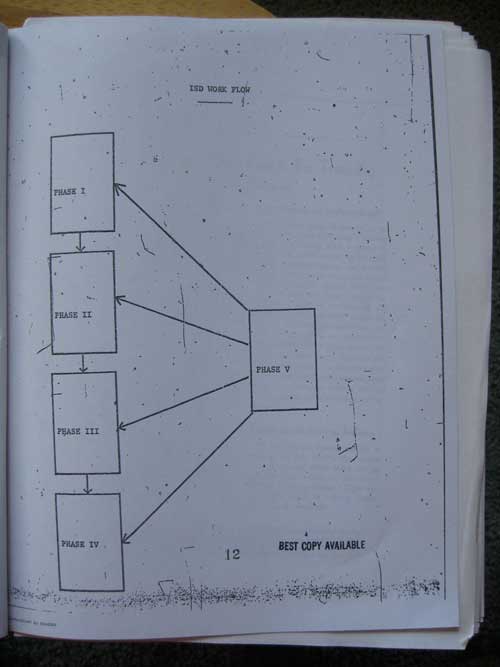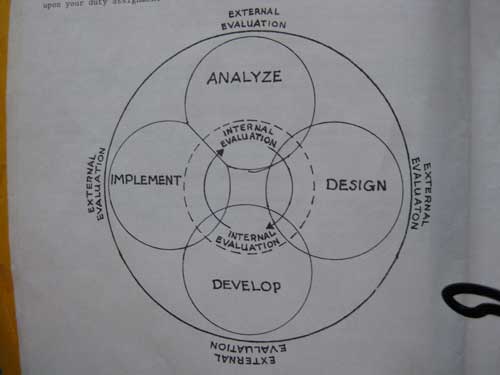Ellen Wagner recently wrote a very good post, What is it about ADDIE that makes people so cranky? in response to a recent #Lrnchat session on Twitter. She followed up on that post with #Lrnchat, ADDIE and Making the World a Better Place.
In her post she wrote, "It seems that the biggest objections to ADDIE are that it is linear." Yes, when ADDIE first made the scene in 1975 it was strictly a waterfall method in that except for the Evaluation phase, which is performed throughout the entire process, the other steps were performed in linear order. For example, in October 1981 Russell Watson presented a paper to the International Congress for Individualized Instruction. He wrote, "The five phases of ISD are analysis, design, development, implementation, and evaluation and control. The first four are sequential in nature, but the evaluation and control phase is a continuous process that is conducted in conjunction with all of the others." He included this diagram with the paper:

Click picture to enlarge
However, by at least 1984 the model evolved into a more dynamic nature for the first four phases. For example, a 1984 Army manual reads, "As the model shows, all parts are interrelated. Changes, which occur during one step of the model, affect other steps. In the ISD process, nothing is done in isolation, nor is all done in a linear fashion; activities of various phases may be accomplished concurrently." This is the model they show:

Click picture to enlarge
Thus even one of the most disciplined and structured organizations had to evolve the model to a more dynamic one. My guess is that since the ISD model was designed at a university, they wanted to take a summative approach in order to evaluate the validity of the learning/training theory. Yet Instructional design practitioners in the real world are more concerned with actually producing an effective learning process to meet the need's of the business, thus they take a more formative approach in order to refine goals and evolve strategies for achieving those goals.
Also note that one other change occurred, the title of the last phase evolved from "Evaluation and Control" to "Evaluation."
References
Watson, Russell (October 1981). Instructional System Development. In a paper presented to the International Congress for Individualized Instruction. EDRS publication ED 209 239.
U.S. Army Field Artillery School (1984). A System Approach To Training. ST - 5K061FD92
2 comments:
ah...plus ca change, plus c'est la meme chose.
Wonderful to see these models!
How interesting to see that our ID forebears were struggling with some of the same kinds of things that we are as we go from Web 1 to Web 2.
1984 was a watershed year in the learning/technology world, with the break-up of AT&T, the introduction of the Macintosh computer, the computer and cable TV industries bumping into one another for the first time... All of a sudden things weren't so linear anymore. The Army model is a great reflection on how those changes affected ISD, making it more iterative,
And now that we can be anywhere, anytime, the notion of linearity seems even more constrained, doesn't it?
Thanks for sharing!
Ellen, I love finding these old models to see how they evolved over time -- and let's hope these models never stop evolving.
Post a Comment